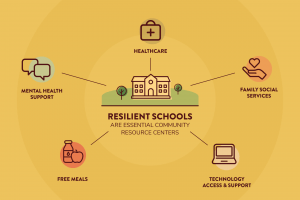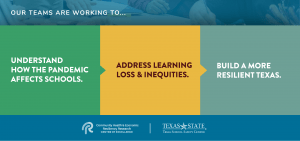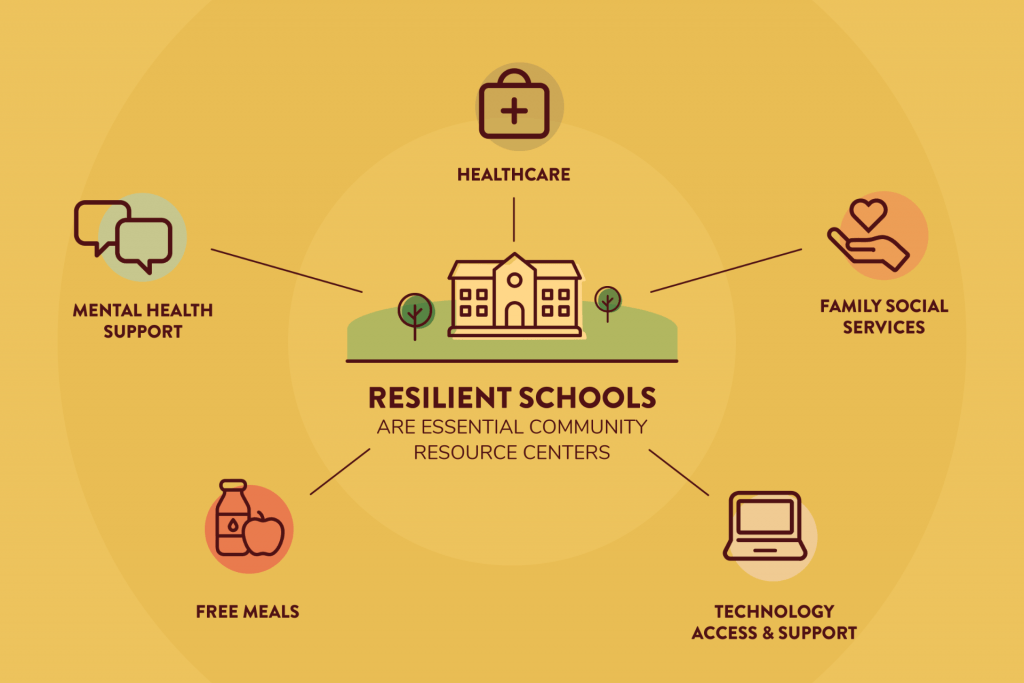With a finger on the pulse of the communities they serve, Texas educators have worked to meet their students’ needs—since long before the pandemic.
Schools serve as a microcosm of society, in that every challenge facing a community also plays out in the classroom. We saw this with COVID-19, as schools were forced to make difficult decisions based on evolving evidence and guidelines.
Texas schools offer an example of how we can adapt and recover from COVID-19 to improve communities’ long-term health, safety, and access to resources. CHERR partnered with the Texas School Safety Center (TxSSC) who is currently researching the impact of COVID-19 in schools. Through this partnership, CHERR and the TxSSC met with educators from around the state to better understand how schools work to build resilience in the face of COVID-19.
Schools provide more than curriculum
Resilient schools are essential community resource centers that promote student safety and wellbeing and connect families with resources to meet basic needs. From providing free meals for students and parent education, to connecting families to mental health support and financial relief, schools across Texas offer programming that builds resilient communities.

Schools stepped up to meet communities’ needs throughout the pandemic, working to protect the health of their students and mitigate learning loss while operating remotely. Understanding that many students rely on schools for nutritious meals, many districts created innovative solutions such as enlisting a fleet of buses to deliver two meals per day to students at their homes. When students faced unequal access to technology, schools found creative ways to provide internet access, as well as providing devices, hotspots, and IT support for students and families.
Texas schools must confront learning loss and other challenges
Even the most resilient schools struggled to prevent learning loss. As evidenced by the 2021 State of Texas Assessments of Academic Readiness (STAAR) results, an increasing number of students are not meeting minimum grade level scores across nearly all major subjects. Meanwhile, students struggle with excessive absences due to COVID-19 exposure or illness, exacerbating learning loss. Young students face challenges with online learning, finding it difficult to stay engaged, frequently disappearing from the screen mid-class, and missing out on traditional socialization and routine.
Special education teachers and students also face unique challenges in online learning platforms. Unable to rely on a one-size-fits-all approach, special education teachers found creative ways to meet student needs. For instance, one special education teacher reflected on the challenges of the online classroom and shared how to adapt individual evaluations by using Google Jamboard, an interactive whiteboard.
Another crucial issue Texas schools face is the struggle to fill educator vacancies as they continue to experience mass resignation. Teachers face difficult decisions about returning to or remaining in the classroom, weighing factors concerning their own health and the health of their families—especially those who live in multi-generational households.
Dr. Shawna White, Research Director at TxSSC, and her team spoke with educators across the state over the past two years. “Not only are educators struggling to cope with the pandemic on a personal level,” she says, “but they are also working tirelessly to maintain a show of strength for their school communities.”
Burnout also remains a risk for educators. To account for vacancies and a shortage of substitutes, teachers often cover multiple in-person classes at a time and, in some cases, are still balancing simultaneous in-person and online teaching. One school nurse reported that in addition to overseeing logistics of weekly COVID-19 testing, nurses are being called upon to assist online learning, teach in-person classes, and call families to check on students’ wellbeing. Despite all of these challenges, schools continue to show resilience in an effort to meet students’ needs.
COVID-19 exacerbated existing inequities
The effects of student learning loss extend far beyond the next grade level. Experts predict implications for graduation rates, workforce development, and community readiness. As a result of the pandemic’s impact on their education, current students may earn $60,000 less over their lifetime.
For students who already faced barriers to education due to racial and socioeconomic inequity, the pandemic presents another layer of challenges, of which learning loss is only one. Class attendance is not the most pressing issue for communities with more immediate needs, including safe housing, medical care, and livable wages to feed their families. The pandemic continues to disproportionately affect people of color, whose communities are burdened with higher rates of infection, hospitalization, and death due to COVID-19.
Texas schools adapt to build resilient communities
Texas educators reach beyond the classroom to collaborate with students’ families and local organizations to build resilient communities. Such essential community-building practices provide solutions to current and future challenges.
Dr. Melinda Villagran, Director of CHERR, says, “Student learning losses are a community problem that will require a community solution.” Teachers who consulted with the TxSSC express similar perspectives.
Teachers also understand that the issues their schools face are shared with educators throughout the state. When students’ scores were down, teachers recognized this as an unfortunate consequence of the pandemic shared across all schools. Such collective experience and understanding provides a sense that everyone is “in it together,” allowing for a team approach to problem-solving.
Despite challenges and an initial learning curve, the shift to online and hybrid learning created more resilient schools. One Texas district’s Safety and Security Director shared that the pandemic has provided a unique learning opportunity for school staff to accelerate technology use to match students’ capabilities, noting, “we have an opportunity to grow along with our students.”
Two years into the pandemic, Texas educators identify opportunities for further growth. Educators express a need for more safety-related training, as well as expanded access and funding for PPE and other safety resources. Additionally, higher salaries, enhanced benefits, and more dedicated planning time would improve work-life balance and increase educator retention rates, all vital components to address learning loss. Still, Texas educators show their love and passion for our future generations by remaining in the profession for the students, while schools continue to provide a safe space to learn and grow.
Even in the face of adversity, educators see a way forward. One dual-language teacher shared that in the past year, “Even though kids came in academically behind, they are much more engaged because they’re so eager to learn and happy to be there and be with their friends.” Such a positive, encouraging vision is exactly what we are pursuing, together—resilient learners who both benefit from and contribute to resilient communities.

About CHERR and TxSSC
The Community Health and Economic Resiliency Research (CHERR) Center of Excellence and the Texas School Safety Center (TxSSC) are two of many research centers serving Texas State’s goal to becoming a first-in-class applied research university committed to building resilience and changing the world.
About the Authors
This piece was written by CHERR faculty in collaboration with TxSSC researchers Shawna R. White, Ph.D.; Tara B. Little, M.A., MBA; and Valerie R. Barnes, M.A.
Get in touch
If you are interested in learning more about, funding a project supported by, receiving a training, or partnering with CHERR or TxSSC, send us a note at helloCHERR@txstate.edu.
By working together, we can apply research to discover solutions. This is TXST NEXT.
